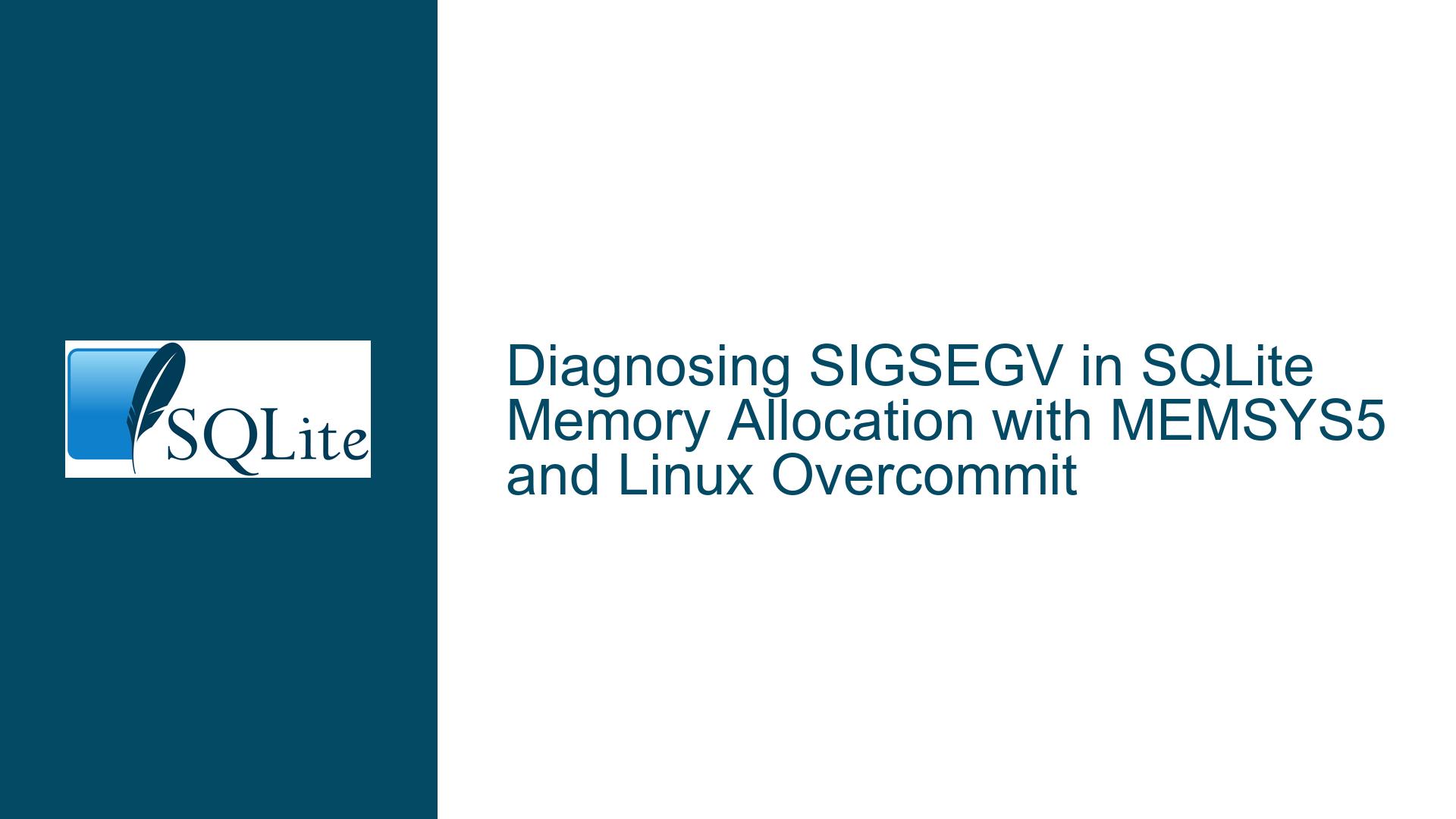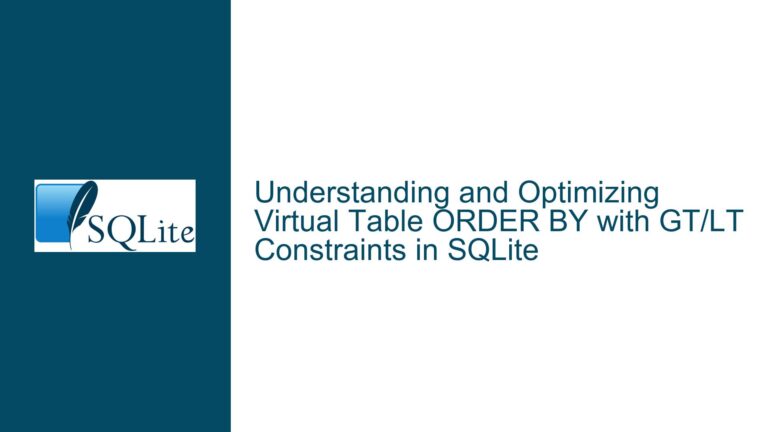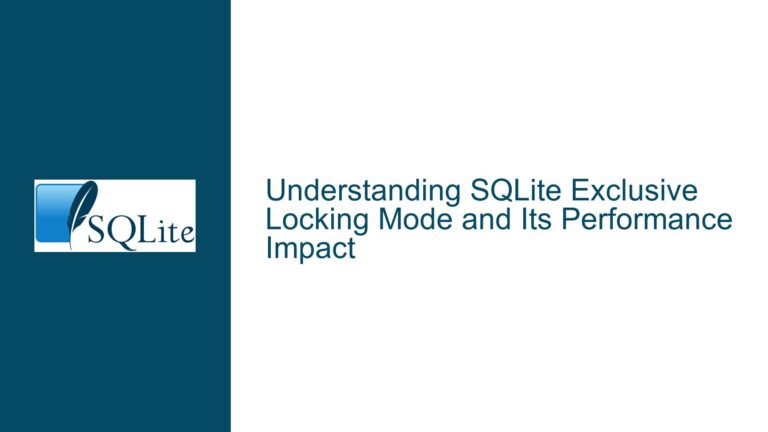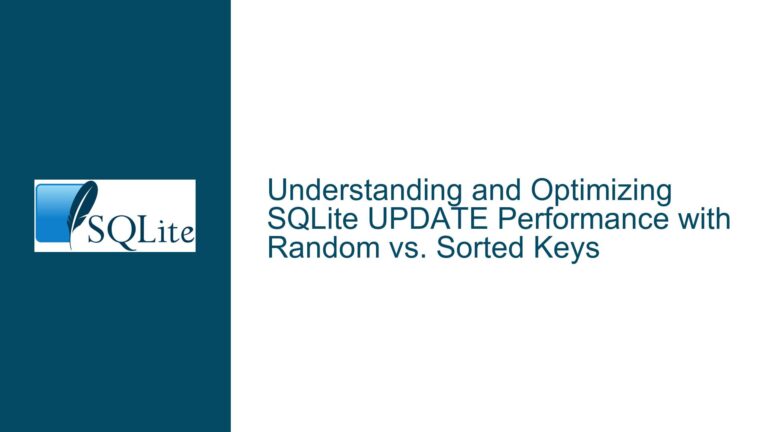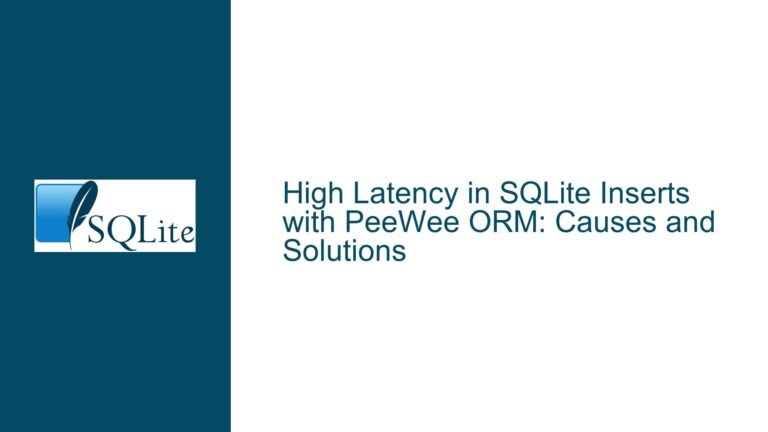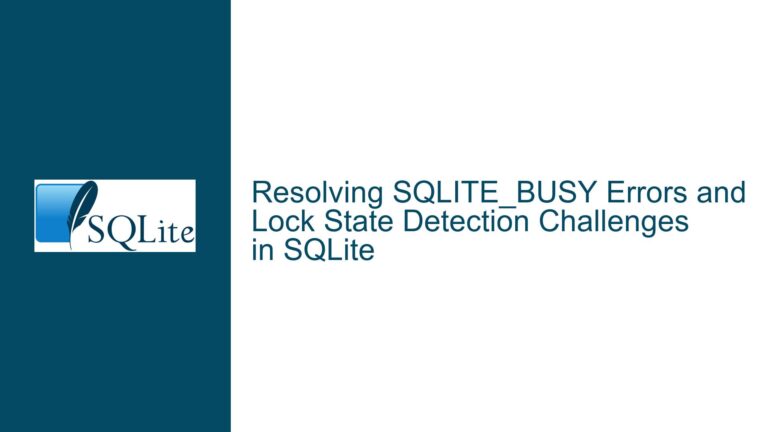Diagnosing SIGSEGV in SQLite Memory Allocation with MEMSYS5 and Linux Overcommit
Understanding the SIGSEGV Crash in SQLite’s Memory Management Subsystem
The core issue involves an embedded Linux process experiencing sporadic segmentation faults (SIGSEGV) during SQLite operations, specifically within the memory allocation subsystem. The crash manifests in the program’s call stack as a failure in libc’s malloc(), which is invoked by SQLite’s internal memory management routines. The process has approximately 50MB of available RAM when crashes occur, ruling out conventional out-of-memory (OOM) conditions. The developer has attempted to mitigate the issue by enabling SQLite’s MEMSYS5 memory allocator, preallocating 10MB of heap space at startup. However, Linux’s memory overcommit behavior complicates this strategy, as the operating system does not physically reserve the preallocated memory until it is actively used. This creates a scenario where SQLite’s memory pool might not be fully reserved, leading to potential conflicts with other memory allocations in the process.
The crash stack trace indicates that the fault occurs during SQLite’s preparation of a SQL statement (sqlite3Prepare), which triggers a chain of memory allocation calls (sqlite3DbMallocZero, sqlite3MemMalloc). The MEMSYS5 allocator is designed to reduce reliance on the system’s malloc() by using a dedicated memory pool, but the observed behavior suggests that either the pool is not being utilized correctly or memory corruption elsewhere in the process is destabilizing SQLite’s memory operations. Critically, the segmentation fault arises in malloc_consolidate, a libc function responsible for managing heap fragmentation, implying that SQLite’s allocator is still interacting with the system heap in a way that exposes it to broader process memory issues.
Key observations:
- The crash occurs in
libc’smalloc()despite MEMSYS5 being active, indicating that SQLite is either falling back to system allocations or the MEMSYS5 pool itself is compromised. - Linux’s overcommit policy allows processes to allocate virtual memory beyond physical + swap limits, but actual page faults occur during write operations. This means MEMSYS5’s preallocated 10MB might not be fully backed by physical memory until SQLite actively uses it.
- The process has non-SQLite components performing frequent dynamic allocations, creating opportunities for heap fragmentation or memory corruption that could indirectly affect SQLite’s operations.
Root Causes: Memory Corruption, Overcommit, and MEMSYS5 Misconfiguration
Memory Corruption in Non-SQLite Code
The most probable root cause is memory corruption elsewhere in the process, such as buffer overflows, use-after-free errors, or uninitialized pointer dereferences. SQLite’s frequent use ofmalloc()andfree()makes it a likely "victim" of heap corruption caused by other components. For example, if a non-SQLite module writes past the end of an allocated buffer, it could overwrite metadata structures used bylibc’s heap manager. Subsequent calls tomalloc()orfree()(including those from SQLite) may then encounter inconsistent heap state, leading to segmentation faults.MEMSYS5 does not fully isolate SQLite from such issues. While MEMSYS5 uses a dedicated memory pool configured via
sqlite3_config(SQLITE_CONFIG_HEAP, ...), this pool is typically allocated using the system’smalloc(). If other parts of the process corrupt the system heap, the MEMSYS5 pool’s management structures could be affected. Additionally, pointers to MEMSYS5-allocated memory might be passed to non-SQLite code, creating opportunities for misuse (e.g., double-free errors).Linux Overcommit and MEMSYS5 Preallocation
Linux’s default memory overcommit behavior allowsmalloc()to return valid pointers even when physical memory is unavailable. The kernel delays physical page allocation until the memory is written to (Copy-On-Write). When using MEMSYS5, the initialmalloc()call to reserve the 10MB pool succeeds, but the memory is not physically backed until SQLite (or the application) touches the pages. If the system’s available memory diminishes over time due to other allocations, SQLite’s subsequent attempts to use its preallocated pool could encounter out-of-memory conditions, leading to undefined behavior.However, the original poster (OP) reports 50MB of free RAM during crashes, making this less likely. A more plausible issue is that the MEMSYS5 pool’s virtual address space overlaps with regions used by other allocators, especially if the pool is not properly initialized. For example, if the application’s non-SQLITE code allocates memory from the system heap after MEMSYS5’s pool is established, the kernel may assign virtual addresses within the MEMSYS5 region, leading to clashes when SQLite later accesses its "reserved" space.
Insufficient MEMSYS5 Configuration or Initialization
MEMSYS5 requires explicit configuration to ensure its memory pool is fully reserved and isolated. The OP’s example program preallocates 10MB but does not force physical page allocation (e.g., by writing to each page). Without this step, the MEMSYS5 pool remains in virtual memory limbo, subject to the kernel’s overcommit decisions. Additionally, if the pool is not aligned or sized appropriately, SQLite’s internal memory management could encounter edge cases when suballocating blocks.Another configuration pitfall involves the use of
SQLITE_ENABLE_MEMSYS5without accompanying settings likeSQLITE_DEFAULT_MEMSTATUS=0to disable memory statistics orSQLITE_OMIT_DEPRECATEDto remove legacy code paths. Unnecessary features might inadvertently trigger systemmalloc()calls, bypassing MEMSYS5.
Resolving the SIGSEGV: Memory Isolation, Corruption Detection, and SQLite Tuning
Step 1: Force Physical Allocation of the MEMSYS5 Pool
To ensure the MEMSYS5 pool is fully backed by physical memory, explicitly initialize every page after allocation:
void *pHeap = malloc(10 * 1024 * 1024);
if (pHeap) {
memset(pHeap, 0, 10 * 1024 * 1024); // Force page faults to commit memory
sqlite3_config(SQLITE_CONFIG_HEAP, pHeap, 10 * 1024 * 1024, 1024);
}
This writes zeroes to the entire 10MB region, triggering Linux to allocate physical pages. Verify this using /proc/[pid]/smaps or pmap to confirm the memory is resident.
Step 2: Detect Memory Corruption with Valgrind or AddressSanitizer
Compile the application with debugging symbols and run it under Valgrind:
valgrind --tool=memcheck --leak-check=full ./your_application
Valgrind will report invalid memory accesses, uninitialized data usage, and heap corruption. For embedded environments, cross-compile Valgrind or use QEMU emulation.
If Valgrind is impractical, use AddressSanitizer (ASan):
gcc -fsanitize=address -g your_source_files.c -lsqlite3
ASan provides detailed reports on memory errors, including the exact line of code causing corruption.
Step 3: Audit Non-SQLite Code for Heap Interactions
Review all components outside SQLite that perform dynamic memory operations. Common culprits include:
- Buffer overflows: Use
strncpyinstead ofstrcpy, and validate input sizes. - Use-after-free: Implement reference counting or use smart pointers in C++.
- Double-free errors: Nullify pointers after
free()and add guard clauses.
Step 4: Minimize SQLite’s Reliance on System malloc()
Configure SQLite to use MEMSYS5 exclusively and disable optional features that invoke system allocations:
sqlite3_config(SQLITE_CONFIG_MEMSTATUS, 0); // Disable memory statistics
sqlite3_config(SQLITE_CONFIG_LOOKASIDE, 0, 0); // Disable lookaside allocator
Recompile SQLite with:
-DSQLITE_ENABLE_MEMSYS5 -DSQLITE_DEFAULT_MEMSTATUS=0 -DSQLITE_OMIT_DEPRECATED
Step 5: Monitor Heap Fragmentation and Address Space Layout
Use mallinfo() or malloc_stats() to track heap usage patterns. High fragmentation could indicate improper allocation sequences. Tools like ltrace or strace can log all malloc()/free() calls, helping identify patterns correlating with crashes.
Step 6: Test Under Memory-Constrained Conditions
Simulate low-memory scenarios using ulimit -v to force the kernel to deny memory requests. This tests whether MEMSYS5’s preallocation truly guards against OOM conditions.
Step 7: Consider Alternative Memory Allocators
Replace libc’s malloc with alternatives like jemalloc or tcmalloc, which offer better fragmentation resistance and debugging features. For embedded systems, dlmalloc (Doug Lea’s malloc) is a configurable option.
By systematically isolating SQLite’s memory usage, validating the MEMSYS5 configuration, and rooting out corruption in non-SQLite code, the SIGSEGV crashes can be resolved or significantly mitigated. The process demands a combination of memory forensics, SQLite tuning, and rigorous code auditing to address the multifaceted interplay between application components and Linux’s memory management.
